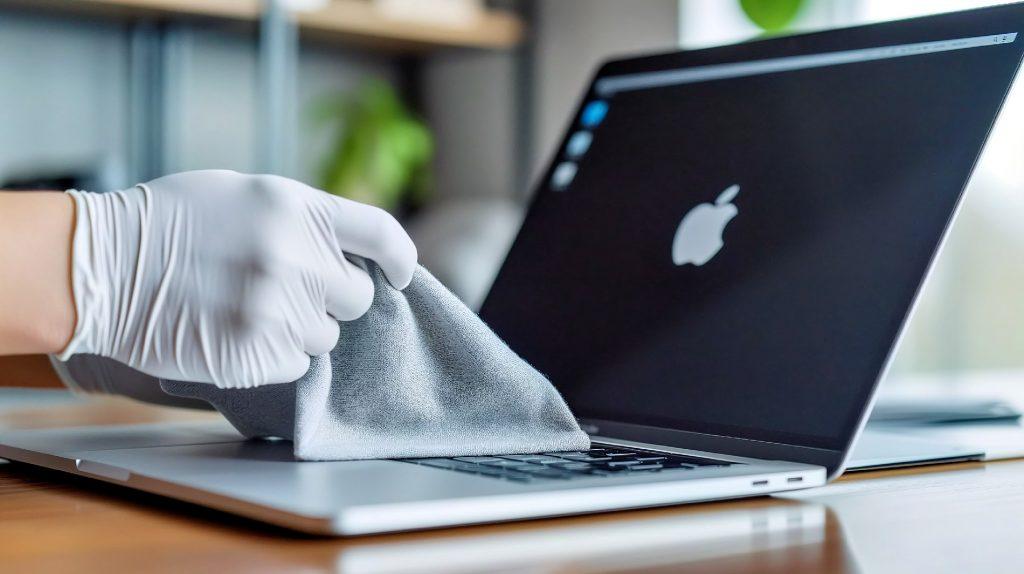Clean MacBook Screen – Best Tips, Worst Mistakes
The Right Way to Clean Your MacBook Display
A clean MacBook screen not only looks better but also reduces eye strain and extends the life of your display. However, improper cleaning can cause permanent damage. This guide shows you exactly how to clean your MacBook display safely and effectively.

Essential Preparation Steps
Before You Start
- Turn off your MacBook completely (not just sleep mode)
- Unplug all cables including the power adapter
- Let it cool down for at least 10 minutes
- Work in good lighting to see all spots and streaks
These steps prevent electrical damage and make it easier to see what you're cleaning.
What You Need (and What to Avoid)
Recommended Supplies
- Microfiber cloth: Soft, lint-free, and non-abrasive
- Distilled water: No minerals that leave spots
- 70% isopropyl alcohol: Apple-approved for stubborn stains
- Screen cleaning solution: Specifically designed for electronics
Never Use These
- Paper towels: Can scratch the anti-reflective coating
- Window cleaners: Contain ammonia that damages the screen
- Household cleaners: Too harsh for delicate displays
- Acetone or nail polish remover: Will destroy the coating
- Bleach or hydrogen peroxide: Extremely damaging
- Abrasive cloths or sponges: Will leave permanent scratches
Step-by-Step Cleaning Process
Step 1: Dry Cleaning
Start with a completely dry microfiber cloth:
- Use gentle circular motions
- Work from the center outward
- Remove dust and fingerprints
- Don't apply pressure
This removes 80% of typical dirt without any risk.
Step 2: Damp Cleaning (If Needed)
For stubborn marks:
- Dampen the cloth slightly – it should feel barely moist, not wet
- Never spray liquid directly on the screen
- Wipe gently in circular motions
- Focus on problem areas without excessive rubbing
Step 3: Drying and Finishing
- Use a dry section of the microfiber cloth
- Remove any moisture immediately
- Check for streaks in different lighting angles
- Let the screen air dry for 5 minutes before closing
Dealing with Specific Problems
Sticky Residue
For adhesive residue or sticky spots:
- Dampen cloth with 70% isopropyl alcohol
- Gently dab the area (don't rub)
- Let it sit for 10 seconds
- Wipe away gently
Keyboard Marks on Screen
Those annoying keyboard imprints:
- Use the dry cleaning method first
- If persistent, use minimal moisture
- Consider a keyboard cover to prevent future marks
- Place a microfiber cloth between keyboard and screen when closing
Protecting Your Display Coating
Understanding Anti-Reflective Coating
MacBook displays have a delicate anti-reflective coating that:
- Reduces glare and reflections
- Can be permanently damaged by harsh chemicals
- Wears off with aggressive cleaning
- Cannot be repaired once damaged
This coating is why gentle cleaning methods are crucial.
How Often Should You Clean?
Recommended Schedule
- Light dusting: Weekly with dry microfiber
- Thorough cleaning: Monthly or as needed
- Deep cleaning: Every 3-6 months
- Professional cleaning: Annually (we offer this free with any service)
Regular light cleaning prevents buildup that requires harsher methods.
Common Cleaning Mistakes to Avoid
The Top 5 Mistakes
- Using too much liquid: Causes seepage into display edges
- Pressing too hard: Can damage LCD pixels
- Cleaning while hot: Liquids evaporate leaving streaks
- Using tap water: Minerals leave spots and residue
- Circular wiping on one spot: Can wear through coating
Professional Cleaning Service
Keep Your MacBook Display Pristine
With proper care and regular cleaning, your MacBook display will maintain its clarity and coating for years. Remember: gentle is always better than aggressive when it comes to screen cleaning.
Quick Reference
- ✅ Microfiber cloth + minimal moisture
- ✅ Gentle circular motions
- ✅ 70% isopropyl alcohol for tough stains
- ❌ Never spray directly on screen
- ❌ Avoid household cleaners
- ❌ Don't use excessive pressure
If you notice coating damage, dead pixels, or other display issues that cleaning won't fix, contact us for professional display repair services.